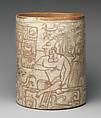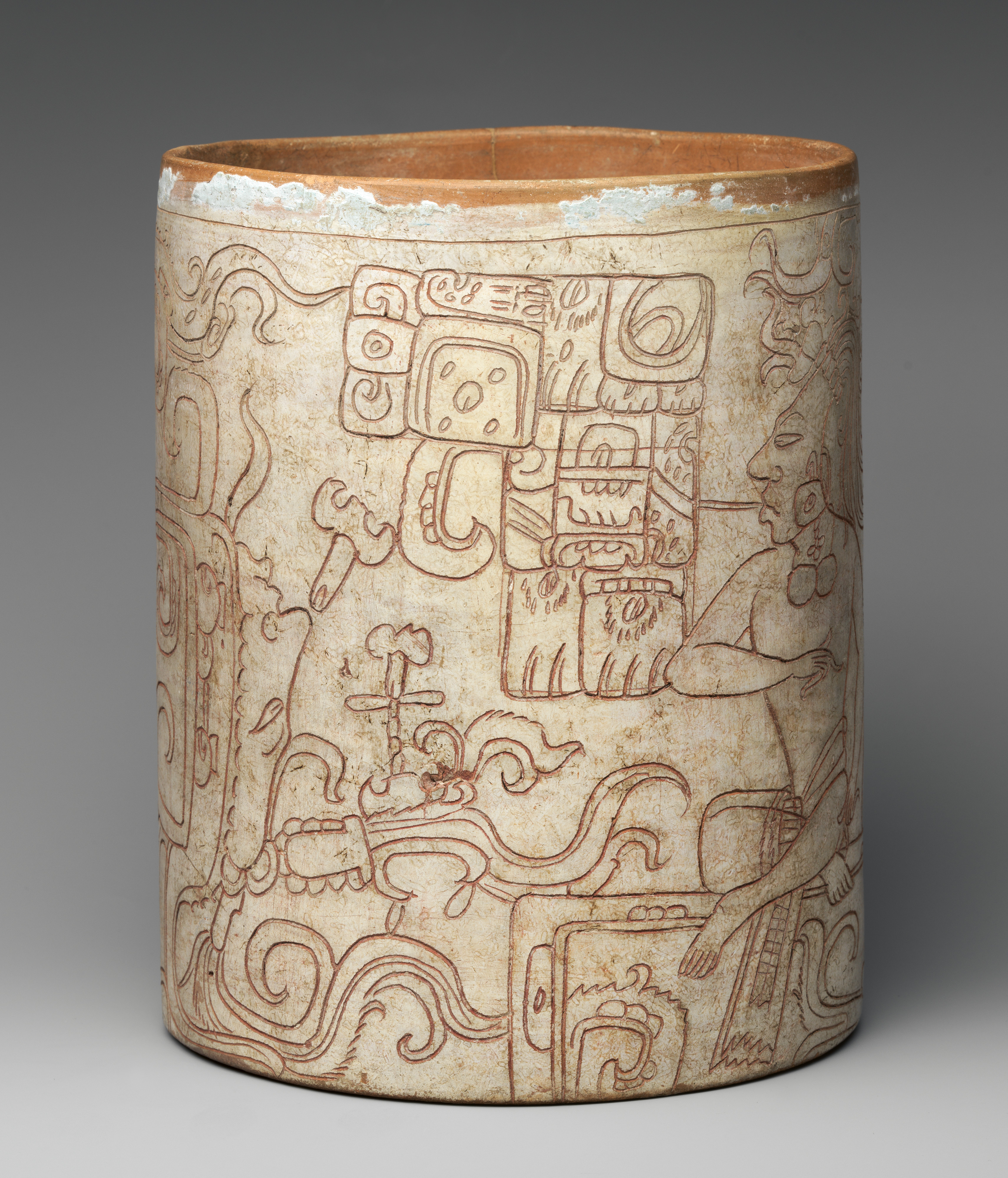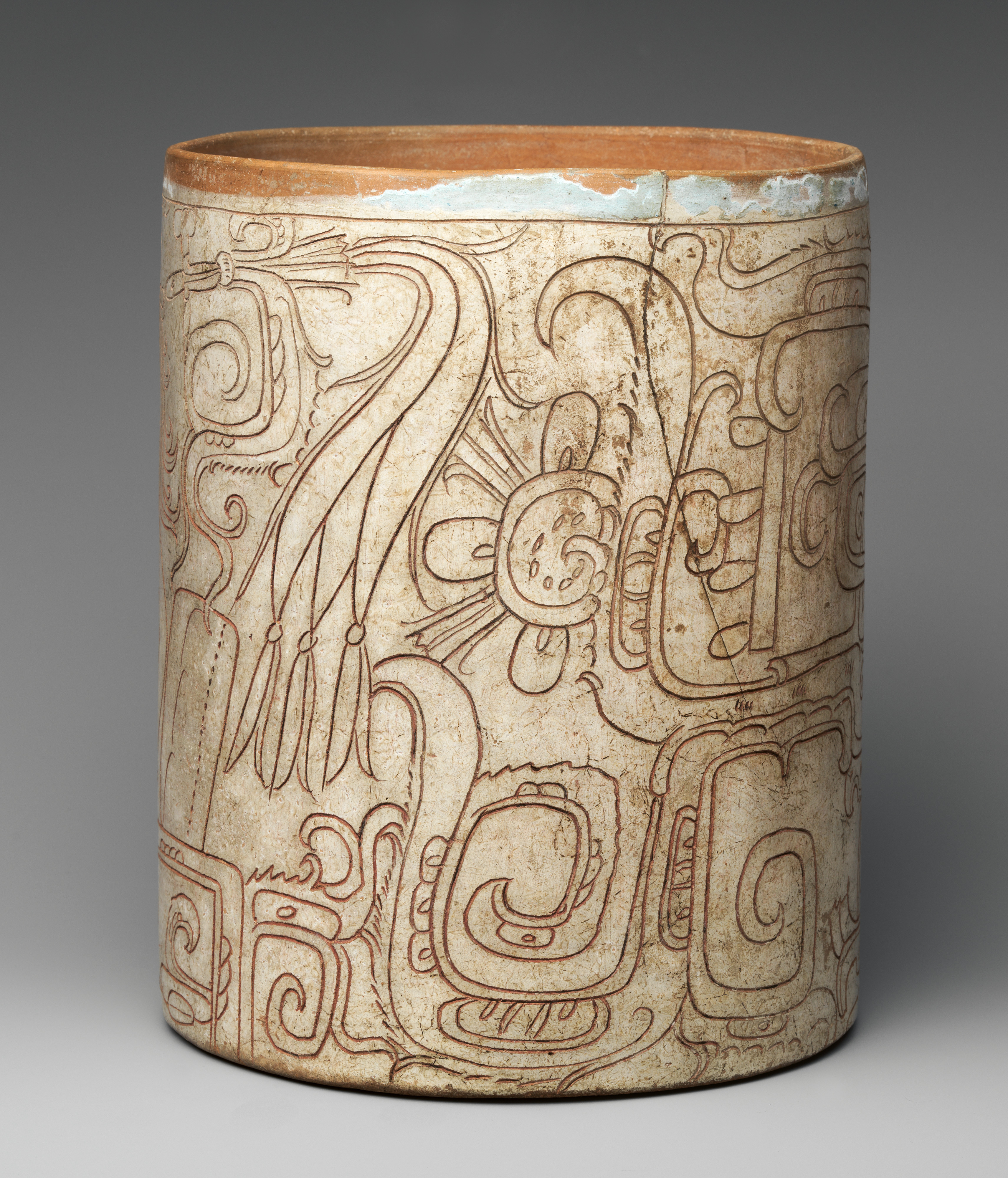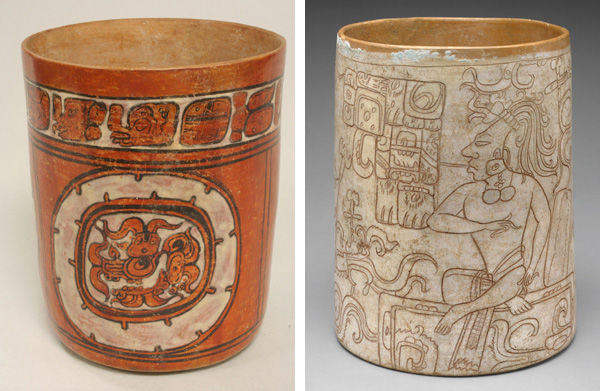Vessel with Seated Lord
Not on view
One of the largest Maya vessels in the Museum, this cup contains an elaborate scene with accompanying text, which reads "yuk'ib baje wa-KAAN TOOK' bakab," or "the drinking cup of Baje(?) Kaan (or Chan) Took', the ruler." The size of the vessel is significant. Other scenes in Maya art that such larger cylinder vessels were placed on the ground as a receptacle for a concoction made of cacao (the plant from which chocolate is derived) poured from a smaller vessel above; the pouring action created the desired froth of the chocolate drink. Presumably, revelers would dip their own cup into the larger vessel to share in the chocolaty celebration.
The text on the Met's chocolate vessel is one of the simplest name tags on a Maya vessel, formed by just a possessed noun and an individual's name, with the implied intransitive "it is." It is possible that the ruler Kaan Took' is seated immediately to the right of the text, his elbow actually overlapping the final syllabic sign, the impersonal royal title. In fact, one gets a sense that the artist meant for the text to appear floating, midair, in front of the person; the elbow passes over the text, but the figure seems to be smoking a cigar, with the smoke passing under the hieroglyphs of his personal name and emerging under the yuk'ib ("his/her drinking cup") glyph block. Although short and sweet, the text here is a dynamic example of the complex interplay between Maya text and image, and how scribes and artists conceived of the vitality and immediacy of hieroglyphic texts vis-à-vis their subjects.
This figure is perched atop a throne that has a cushion for reclining. He wears a woven loincloth, a necklace perhaps composed of the two joined halves of a bivalve shell, and ear flares similar to other Metropolitan Museum objects, such as 1989.314.15a,b. His forehead slopes back, indicative of cranial deformation, and his cascading curly locks are held back by a specific royal headband made of jadeite beads—a distinctive item worn by Maya kings and queens. A large headdress element shoots out from the rear of the figure's head, and the vivid incisions of the artist capture the movement of the long tail feathers of the quetzal bird (Pharomachrus mocinno).
The rest of the scene does not show a royal court, as commonly portrayed on other Maya vessels. Instead, a large, toothless deity head sprouting watery vegetation accompanies the ruler. The supernatural's image perhaps tells the viewer of the scene that it takes place in a certain location or during a certain event, the details of which are lost on modern observers. One fascinating detail of the deity head is the upside-down, human-like profile that sprouts up from the rear—most likely representing the head of the Maya maize god as an ear of corn. The theme of the disembodied head of the maize god being reborn from sprouting vegetation is common among Maya vessels. Thus the artist of the Metropolitan Museum's vessel connects the ruler pictured here with agricultural fertility and the mythic cycle of maize, the main staple crop of the ancient Americas. The themes of bountiful food incised on the outside of the vessel inform its function as a container of chocolate crucial for royal feasts.
Although the text marks the owner of the cup as a bakab noble, it does not specify from which polity the ruler hails, but a similar name appears on one of the inscribed mud bricks from the acropolis of the site of Comalcalco, Tabasco, Mexico. The hypothesis that this particular vessel comes from the Tabasco region gains support from archaeological evidence published in the mid-twentieth century by Heinrich Berlin, incidentally one of the early figures in the decipherment of Maya hieroglyphic writing. Berlin published a drawing of a pottery type from the site of Jonuta, Tabasco, that he called thin-walled cylinders, with a "white slip through which geometric and/or human figures are incised."
The vessel at the Met shares formal and technical characteristics from this class of objects identified by Berlin from the late eighth century A.D. Here the artist or owner of the pot seems to have added a thin layer of blue-painted stucco around the rim as a final ornamentation. There are several similar vessels in museum and private collections, including one at the Dallas Museum of Art, many of which have been documented by Justin Kerr's Maya Vase Database project.
The Met's vase was first published in 1961 in Europe and identified as a "large Maya clay pot with incised drawing" ("Großes Tongefäß mit eingeritzter Zeichnung") from the Yucatan peninsula, and in 1964 was described as being located in a private collection in Switzerland. In fact, the ruler pictured on the vessel served as the cover model for the 1964 publication.
James Doyle
See more on Now at the Met
Due to rights restrictions, this image cannot be enlarged, viewed at full screen, or downloaded.
This artwork is meant to be viewed from right to left. Scroll left to view more.







